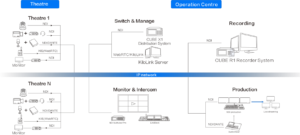H.264 is a compression technology for video encoders. The video encoding standard obtains the best image quality at the lowest bit rate (or storage capacity) possible. h264 encoding compression technology was first started in 1998. At the time, ITU-T Study Group 16 launched another research project H.263 while continuously improving H.263. 26L, the goal is to develop a new standard that doubles the coding efficiency at that time.
With the continuous expansion of the video image transmission field, the compression technology of the h.264 video encoder solves the problems of the current coding standards with higher coding efficiency and concise expression. It focuses on the adaptation to mobile and IP networks and adopts layering. Technology, which isolates coding from channels in the form, essentially considers the characteristics of the channel in the source encoder algorithm and further approaches the actual application. Its application prospect is self-evident.
Compared with previous video coding standards, H.264 integrates many new video compression technologies, which have higher compression efficiency and image quality. Under the same image quality conditions, the data compression ratio of H.264 is 2 to 3 times that of the current DVD system MPEG-2, 1.5 to 2 times higher than MPEG-4, and it has better network friendliness. But the price of high compression ratio of H.264 is that the computational complexity of the encoder is greatly increased.H.264 uses “network-friendly syntax to enhance the adaptability to various channels, which is beneficial to the processing of bit errors and packet loss; the application target range is wide, which can meet different rates, different resolutions, and different transmission (storage) The needs of the occasion.The main advantages of H.264:
Under the same visual conditions, the compression ratio is higher. At the same reconstructed image quality, H.264 reduces the code rate by 50% compared to H.263 + and MPEG-4 (SP).
It has better support for network transmission, low-latency mode required for interactive applications, random frame request, variable bit rate, and multiple resolutions. It has strong adaptability to channel delay. It can be used for low-latency real-time services (such as conference television) and occasions without delay limitation (such as video storage).
Improve network adaptability, adopt “network friendly” structure and syntax, have strong ability to resist bit errors, strengthen the handling of bit errors and packet loss, and improve the error recovery ability of the decoder. Can adapt to video transmission in different networks, network affinity is good.The encoder and decoder are designed with complexity scalability, and can be scaled between image quality and encoding processing to adapt to applications of different complexity.
Based on the h264 video encoder, Kiloview has 2 star products. The E series wired live encoder can compress the SDI or HDMI video source code and push it to the Internet live platform through wired Ethernet transmission to realize long-distance HD transmission / live broadcast of video. It also supports video recording function and is a low cost video encoding device.
G series wireless video encoders can compress SDI or HDMI video source codes into network streams. Through wired / WIFI / expand 4G network, it can realize long-distance high-definition video transmission on Internet WAN or local area network LAN.










